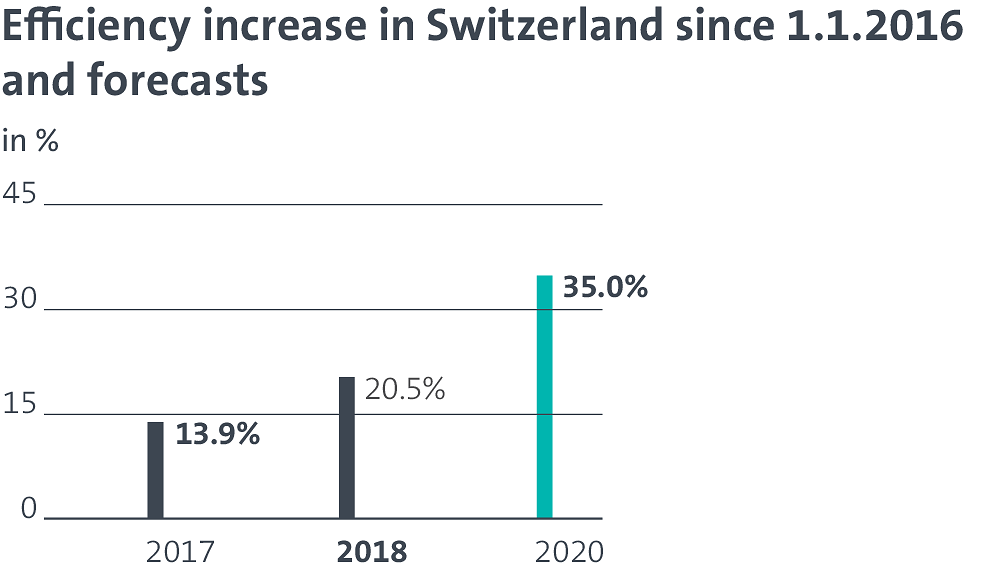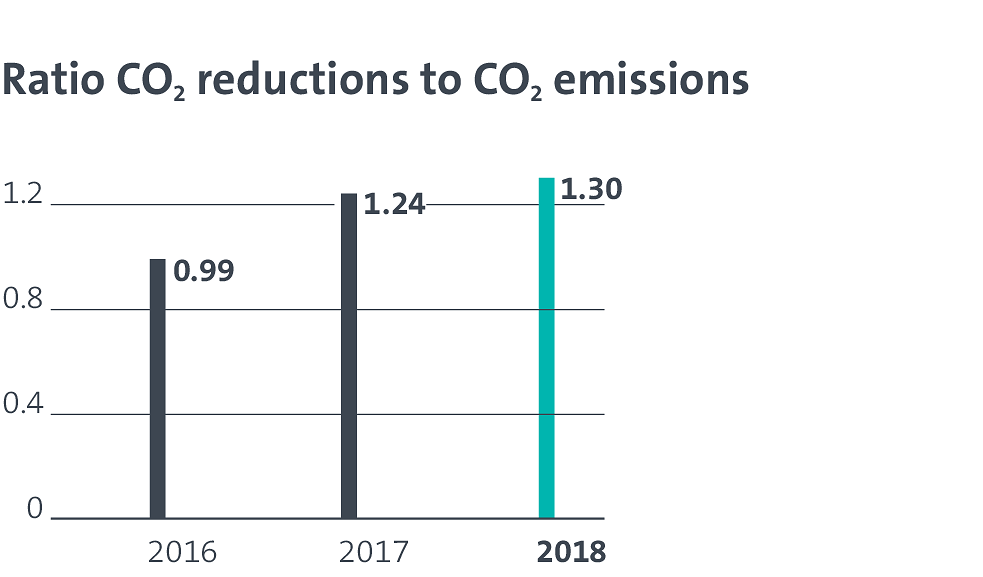Management approach
In view of the national and international climate situation, the issues of climate change and energy efficiency are particularly important for Swisscom as a major consumer of energy as well as for its stakeholder groups. The climate scenarios for Switzerland published in November 2018 give an idea of the possible consequences of climate change in Switzerland. The scenarios presented, which were put together by the National Centre for Climate Services (NCCS), cannot be ignored. Climate change and energy efficiency are therefore at the heart of Swisscom’s sustainability strategy.
The Swiss people adopted the Energy Act (EnA) in a referendum in May 2017. Together with the CO2 Act as the foundation of the Confederation’s energy and climate strategy for 2050, the EnA defines the framework for Swisscom’s business activities. Swisscom is paying particular attention to increasing its own energy efficiency and climate protection. With that in mind, it has set itself two goals:
- Increased efficiency: Swisscom has determined its energy requirements until 2020 and plans to increase its energy efficiency 35% by the end of 2020 compared to 2016. Based on current scenarios, in autumn 2018 Swisscom also determined its energy requirements to the end of 2025. Thanks to newly implemented measures and technical improvements, it intends to increase its energy efficiency by a further 24% over the next eight years.
- Climate protection: Swisscom aims to work together with its customers to save twice as much CO2 as it emits throughout the entire company and its supply chain by 2020. This undertaking has been summarised as the “2:1 target”. Swisscom aims to achieve the 2:1 target by reducing emissions and by promoting and marketing its sustainable portfolio. Based on current scenarios, in autumn 2018 Swisscom also estimated the CO2 emissions resulting from its energy requirements to the end of 2025. Swisscom is now striving to further reduce its CO2 emissions.
Swisscom has agreed targets with various partners, in each case with the aim of increasing efficiency and reducing CO2 emissions. The targets for energy consumption (energy efficiency) and CO2 reduction (CO2 intensity) are defined differently depending on the reference value with regard to the base year, the framework and the target achievement year. Swisscom has agreed targets with the Energy Agency for Industry (Energie-Agentur der Wirtschaft – EnAW), the “Exemplary Role of the Confederation in Energy” (ERCE) and the Science Based Target Initiative (SBTI). Swisscom already reported its emissions reduction in 2016 to the SBTI. The SBTI is a partnership between the Carbon Disclosure Project (CDP), the UN Global Compact initiative, WWF and the World Resources Institute (WRI). It classifies company reduction targets as “science-based” if they are in line with the level of reduction in CO2 required to keep the global temperature increase below 2°C. Swisscom is also committed to reducing its Scope 1 emissions by 10%, Scope 2 emissions by 100% and Scope 3 emissions by 18% compared to 2013 by 2020. The SBTI recognised all Swisscom’s reduction targets at the end of 2016.
See www.sciencebasedtargets.orgPartnership |
Target agreement |
Start year January 1st |
Target year Dec. 31st |
Target |
||||
|---|---|---|---|---|---|---|---|---|
| Swisscom | Ratio CO2 savings achieved by customers to CO2 emissions Swisscom | 2016 | 2020 | 2:1 | ||||
| Swisscom | Energy efficiency (savings measures over total energy consumption, not weighted) | 2016 | 2020 | +35% | ||||
| EnAW | Energy efficiency (savings measures over total energy consumption, not weighted) | 2013 | 2022 | +35% | ||||
| EnAW | CO2 intensity of heating fuels (CO2 emissions as a proportion of total CO2 emissions) and CO2 savings) | 2013 | 2022 | 92% | ||||
| EnAW | CO2 intensity of fuels (CO2 emissions as a proportion of total CO2 emissions) and CO2 savings) | 2013 | 2022 | 76% | ||||
| VBE | Energy efficiency (savings measures over total energy consumption, not weighted) | 2006 | 2020 | +25% | ||||
| SBTI | CO2 Reduction Scope 1 | 2013 | 2020 | -10% | ||||
| SBTI | CO2 Reduction Scope 2 | 2013 | 2020 | -100% | ||||
| SBTI | CO2 Reduction Scope 3 | 2013 | 2020 | -18% |


Additional details about further environmental aspects that Swisscom takes into account in operations can be found at the end of this section. The environment and purchasing policies form the basis of sustainable resource usage for Swisscom. The management approaches employed by Swisscom to increase energy efficiency and combat climate change fundamentally consist of its environmental management system and associated specific approaches. Management norms, standards and internal directives allow the planned saving and efficiency measures to be systematically implemented. Swisscom subsidiaries with operations that are of significant environmental importance are ISO-14001-certified. These are Swisscom (Switzerland) Ltd, Swisscom Broadcast Ltd and cablex Ltd, which are also certified to ISO 9001. The Italian subsidiary Fastweb S.p.A. is also ISO-14001-certified. The management systems and processes certified to ISO 14001 include – with regard to the number of employees – more than 94.2% of the Swisscom Group (including Fastweb; prior year: 94.3%). The environmental management system and its efficiency are subject to an annual external audit.